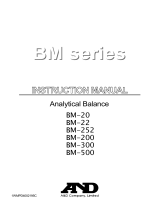Page is loading ...

GX-02 USB Interface Instruction Manual
1. Features
x The GX-02 USB interface connects a GX or GF series multi-function balance to a personal computer and is used
to transmit the balance weight data to the personal computer via USB. Applicable operating system is
Windows 98 or later.
x As the Windows standard driver is used to transmit the weight data, complicated installation of a dedicated
driver is not necessary.
x The personal computer recognizes the GX-02 interface much like a keyboard, and processes the weight
data in the same way as values input by key operation. Thus, the balance weight data can be transmitted to
applications such as Excel, Word and memo pad for Windows.
x A USB cable is provided (Approx. 2 m length).
Note: x Only weight data can be transmitted. Headers and units can not be transmitted.
x Time and date, ID number, data number and GLP report are not output.
x Data transmission from the personal computer to the balance is not available. To control the
balance by a command, install the RS-232C board and connect the balance and the personal
computer using the RS-232C cable.
x
Turn off the screen saver or suspend mode of the personal computer.
x
Windows, Word and Excel are the registered trademarks of the Microsoft Corporation
.
2. Installation Procedure
Note: Before installing the GX-02 option board, be sure to disconnect
the AC adapter from the balance.
Step 1 Remove the two screws and pull out the RS-232C board
gently. Do not pull on the cable excessively.
Step 2 Remove the connector from the RS-232C board. At this
time, be sure to hold the connector with your hand. Do not
pull on the cable.
Step 3 Insert the connector into the GX-02 option board.
Step 4 Install the GX-02 option board in the balance and secure
it using the two screws that were removed in step 1.
3. How to Use
Step 1 Turn the personal computer on to start up Windows. And then, connect the AC adapter to the balance
and turn the balance power on.
Step 2 In the balance function table, set “Baud rate” to “2400 bps (bp5 2)”, “Data bit, parity bit” to “7 bits, even
(btpr 0)” and “Data format” to “A&D standard format (type 0)”. (Same as the factory settings)
Step 3 Connect the balance to the personal computer, using the provided USB cable.
Note: When connecting the USB cable, be sure that the balance “Data output mode” is set to a mode
other than “Stream mode (
prt 3
)”.
Step 4 For the first connection, the driver will be installed automatically. Please wait until the driver installation
is completed. This step is not required for later connections.
Step 5 Start up the application (such as Excel) into which you want to transmit the balance weight data.
Place the cursor in the position at which you want to enter the balance weight data.
Step 6 Press the balance PRINT key and the weight data will be transmitted into the application at the cursor position.
Note: When the data stored in memory is to be output at one time, the data number is not available. Set “Data
number output” to “No output (
d-no 0
)” and “Data output pause” to “Pause (1.6 seconds) (
pU5e1
)”.
Step 7 To finish the operation, disconnect the USB cable.
4. Note on Use
If you are using Windows XP and data cannot be input correctly into Excel, turn off Advanced text services using
the following procedure. Other compatible operating systems do not have this function.
Step 1 In Control Panel, click Regional and
Language Options.
Step 2 Click the Languages tab, and then click
the Details button.
Step 3 Click the Advanced tab, and then select
the Turnoff advanced text services
check box.
5. Example of Use
x Weight data collection 1 (Basic use)
Balance data output mode: Key mode (factory setting)
dout 0
Press the balance PRINT key to transmit the weight data to the personal computer.
x Weight data collection 2
Balance data output mode: Auto print mode
dout 1
or
dout 2
When a sample is placed on the balance and the displayed value is stable, the balance transmits the weight
data to the personal computer.
Useful when you want to repeatedly add samples and record the weight data.
RS-232C
board
GX-02 option board
Screw
Screw
Step 1
Step 2
Step 3
Step 4
/








